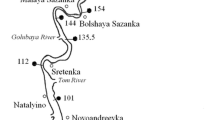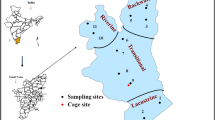Abstract
The Yamuna river is the largest tributary of the Ganges river system. It originates in the Himalayas and flows through a varied geological terrain encompassing a large basin area. Metals Fe, Mn, Pb, Zn, Cu in different chemical fractions of suspended sediments such as exchangeable, carbonates, Fe−Mn oxides, organics and residual fractions were studied. Phosphorus associated with different chemical forms are discussed. The metals are mostly associated with residual fractions in the sediments followed by organics, Fe−Mn oxides, exhangeable and carbonates. Intensive use of chemical fertilizers and pesticides in agriculture in the basin affects the high inorganic phosphorus content in sediments.
Similar content being viewed by others
References
Auruda, K. D.: 1983, ‘Physiographic and Anthropogenic Controls of Global and regional Ionic Runoff’, in: Webb, B. W. (ed.), Dissolved Loads of Rivers and Surface Water Quantity/Quality Relationship, Proc. Symp Hamburg, IAHS Publ. No. 141: 31–39.
BalachandA. N. and NairS. M.: 1994, ‘Fractionation of Phosphorus in the Sediment of a Tropical Estuary’, Env. Geol. 23, 284–294.
BernerR. A. and RaoJ. L.: 1994, Phosphorus in Sediments of the Amazon River and Estuary: Implications for Global Flux of Phosphorus to the Sea, Geochim. et Cosmochim. Acta 58(10), 1333–2339.
BostromB., AndersenJ. M., FleischerS. and JanssonM.: 1988, Exchange of Phosphorus Across the Sediment-Water Interface, Hydrobiologia 170, 229–244.
CBPCWP: 1982, The Yamuna Sub-Basin, Central Board of the Prevention and Control of Water Pollution, New Delhi, 114 pp.
DeurerR., ForstnerU. and SchmollG.: 1978, ‘Selective Chemical Extraction of Carbonate Associated Trace Metals in Recent Lacustrine Sediments’, Geochim. et Cosmochim. Acta 42, 425–427.
EnglerR. P., BrannonJ. M., RoseJ. and BighamF.: 1977, ‘A Practical Selective Extraction Procedure for Sediment Characterisation’, in: ChenT. F. (ed.), Chemistry of Marine Sediments. Ann Arbor Sci. Publ, Ann Arbor, Michigan, pp. 163–171.
ErelY and MorganJ. J.: 1991, ‘The Effect of Surface Reactions on the Relative Abundances of Trace Metals in deep-Ocean Water’, Geochim. et Cosmochim. Acta 55, 1807–1813.
Flanagan, F. J.: 1976, ‘Dispersion and Analysis of Eight new USGS Rock Standards, U. S. Geol. Surv. Prof. Pap, 840 pp.
ForstnerU. and WittmannG. T. W.: 1981, Metal Pollution in the Aquatic Environment (2nd edn), Springer-Verlag, Berlin, 486 pp.
FroelichP. N., BenderM. L. and LuedtkeN. A.: 1982, ‘The Marine P Cycles’, J. Sci. 282, 47–51.
GarrelsR. L., MackenzieF. T. and HuntC.: 1975, Chemical Cycles and the Global Environment, William Kauffmann Inc. New York, 206 pp.
GibbsR. J.: 1973, ‘Mechanism of Trace Metal Transport in Rivers’, Science 180, 71–73.
GibbsR. J.: 1977, ‘Transport Phases of Transition Metals in the Amazon and Yukon Rivers’, Geol. Soc. Amer. Bull. 88, 829–843.
HieltjesA. H. M. and LijklemsL.: 1980, ‘Fractionation of Inorganic Phosphorus in Calcareous Sediments’, J. Env. Qual. 9, 405–407.
HosomiM. Okada, and SudoR.: 1982, ‘Release of P from Lake sediments’, Env. Intl. 170, 19–34.
JhaP. K. SubramanianV., SitasawadR. and vanGriekenR.: 1990, ‘Heavy Metals in Sediments of the Yamuna River (A Tributary of the Ganges). India. Sci. Tot. Env. 95, 7–27.
KromM. D. and BernerR. A.: 1981, ‘The Diagenesis of P in a Near Shore Marine Sediment’, Geochim. et Cosmochim. Acta 45, 207–216.
MayerY. and WilliamsJ. D. H.: 1981, ‘Modified Procedure for Determining the Forms of P in Freshwater Sediments’, Tech. Bull.. No. 119, NWRI, Canada, Ontario, 8 pp.
McGlatheryK. J., MarinoR. and HowarthR. W.: 1994, ‘Variable Rates of Phosphate Uptake by Shallow Marine Carbonate Sediments: Mechanisms and Ecological Significance’, Biogeochemistry 25, 127–146.
PettersonK., BostromB. and JacobsenO. S. 1988, Phosphorus in Sediments-Speciation and Analysis, in: PerssonG. and JannssonM. (eds.) Phosphorus in Fresh Water Ecosystems. Developments in Hydrology, Kluwer Academic Publishers, Dordrecht, pp. 91–101.
ProbstJ. L.: 1986, Dissolved and Suspended Matter Transported by the Girou River France. Hydrological Sciences’, J. des Sciences Hydrologiques, 31, 61–79.
RuttenbergK. C.: 1992, ‘Development of a Sequential Extraction Method for Different Forms of P in Marine Sediments’, Limnol. Ocean. 37(7), 1460–1482.
Salomons, W. and Mook, W. G.: 19978, ‘Processes Affecting Trace Metals in Lake Ijssel’, Abs. 10th Int. Cong. on Sedimentology, Jerusalem, pp. 569–570.
ShibuM. P., BalachandA. N. and NambisanP. N. K.: 1990. ‘Trace Metal Speciation in a Tropical Eastuary — significance of Environmental Factors’, Sci. Tot. Env. 97/98, 267–287.
StoneM. and EnglishM. C.: 1993, ‘Geochemical Composition, Phosphorus Speciation and Mass Transport of Fine Grained Sediment to Two Lake Erie Tributaries’, Hydrobiologia 253, 17–29.
SundbyB., GobeiC., SilverbergN. and MucciA.: 1992, ‘The Phosphorus Cycle in Coastal Marine Sediments’, Limnol. Oceano. 37, 1129–1145.
TessierA., CampbellP. G. C. and BissonM.: 1979, ‘Sequential Extraction Procedure for the Speciation of Particulate Trace Metals’, Anal Chem. 51, 844–851.
WarrenL. J.: 1981, ‘Combination of Sediments by Lead, Zinc and Cadmium—a Review’, Env. Poll. Ser. B 2, 410–436.
WarrenL. A. and SimmermannA. P.: 1994, ‘Suspended Particulate Oxides and Organic Matter Interactions in Trace Metal Sorption Reaction in a Small Urban River’, Biogeochemistry 23, 21–34.
YamadaH. and KayamaM.: 1987, ‘Distribution and Dissolution of Several Forms of Phosphorus in Coastal Marine Sediments’, Oceanologica Acta 10, 311–321.
Author information
Authors and Affiliations
Rights and permissions
About this article
Cite this article
Chakrapani, G.J., Subramanian, V. Fractionation of heavy metals and phosphorus in suspended sediments of the Yamuna river, India. Environ Monit Assess 43, 117–124 (1996). https://doi.org/10.1007/BF00398602
Issue Date:
DOI: https://doi.org/10.1007/BF00398602




